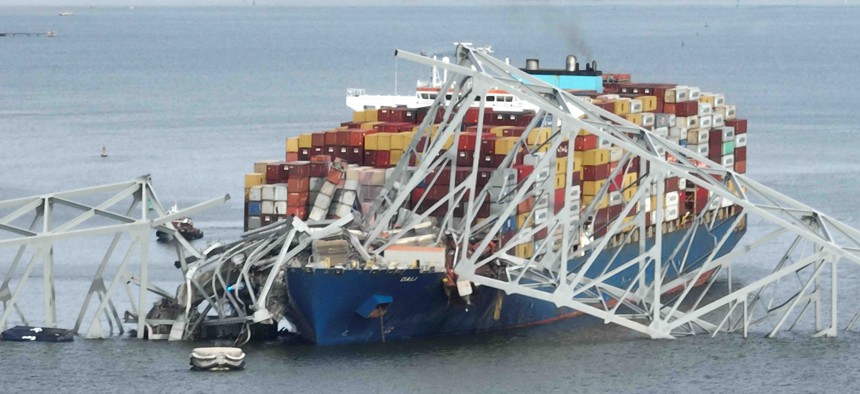Massive ships make protecting bridges a much tougher task

In this aerial image, the steel frame of the Francis Scott Key Bridge sits on top of a container ship after the bridge collapsed, Baltimore, Maryland, on March 26, 2024. JIM WATSON/AFP via Getty Images
As officials evaluate replacing Baltimore’s Francis Scott Key Bridge, they must consider the weight and size of increasingly large vessels.
As questions mount over how a Baltimore bridge collapsed early Tuesday, engineering and transportation experts warned that many seemingly simple ways to prevent those types of crashes in the future might not be feasible.
Many observers have questioned whether better shielding of the bridge piers might have diverted the ship away from supports. Groups of pilings known as “dolphins” are often used near bridge piers, for example, to prevent collisions with ships. Others have raised the idea that stronger piers could better withstand the impact of ocean-going vessels.
But those safety measures, experts say, would have been no match for a vessel like the Dali, a 200-million pound ship carrying 4,700 containers the size of truck trailers, traveling at 8.5 knots. Transportation Secretary Pete Buttigieg pointed out during a White House briefing Wednesday that the Dali is roughly the size of a Nimitz class U.S. Navy aircraft carrier.
“It’s difficult to overstate the impact of this collision,” Buttigieg told reporters. “It’s not as big as a building. It’s as big as a [city] block—100,000 tons—all going into this pier at once.”
“Part of what's being debated is whether any design feature now known would have made a difference in this case,” he added.
Investigators from the National Transportation Safety Board are currently investigating which factors—perhaps including design flaws—contributed to the collapse of the Francis Scott Key Bridge. Their findings could take weeks or months to deliver.
But as public officials and engineers contemplate what kind of bridge might replace the 47-year-old steel span that now lies in the Patapsco River, they’ve faced questions about the kinds of safety features that could prevent a similar disaster in the future.
Container vessels have grown larger in recent years, particularly after the Panama Canal expanded in 2016 to handle larger “Neopanamax” vessels such as the Dali. That vastly increases the amount of impact a bridge support would have to absorb to handle a head-on collision like Tuesday’s.
“There’s little evidence that it’s economically feasible to create a protection system for a cargo ship that is coming at a full straight-on blow,” said Ben Schafer, a professor of civil and systems engineering at Johns Hopkins University in Baltimore. Any protection system would have to divert an oncoming ship away from the pier from far away, he said.
“Could we build a Fort Knox or a nuclear bunker in front of every bridge? It's structurally possible, but it's not economically feasible,” he added. But Schafer said he was “unconvinced” that “even the most extreme bridge protection systems” would have protected the Francis Scott Key Bridge from the Dali.
Kancheepuram N. Gunalan, a past president of the American Society of Civil Engineers, also questioned the wisdom of building a new bridge to such high specifications.
“Engineers can design for a lot of things,” he said. “But the question is: Do we have the funds to be able to build something like that? These bridges are designed for ice loads, wind loads, seismic loads and also impacts from vessels. Engineers have to be able to build something, build it quickly and make sure it’s economically efficient.”
It will take a year or two under a best-case scenario to replace the Baltimore bridge, Gunalan said. But that would only be possible if local, state and federal agencies streamline their normal procedures to speed the reconstruction. Otherwise, rules governing procurement, labor, the environment and shipping could stretch out the process.
“Everybody needs to do their part in streamlining their processes,” Gunalan said. “There are procurement methodologies these days so you don’t have to wait for the design to be complete [to move to the next step], you can do it through alternate delivery to accelerate construction. There are a lot of things that can be done to speed up the process, but [officials] need to be looking at this with an open mind and have some confidence and trust in the industry and in the profession. But don’t try to cut any corners.”
Of course, a new bridge would be the final step in a long process. Currently, the U.S. Army Corps of Engineers is working on how to clear debris from the bottom of the river, which would allow the Port of Baltimore to resume normal operations. Buttigieg declined to say how long that would take, but Gunalan estimated that it could be “a matter of weeks.”
Buttigieg said President Joe Biden indicated he wanted reconstruction to proceed as quickly as possible. “We have a clear direction from the president to tear down any barriers—bureaucratic as well as financial—that could affect the timeline of this project,” he said.
“It is not going to be simple,” the transportation secretary added. The federal government helped Pennsylvania and California open collapsed highway bridges recently, but those were “comparatively short spans of bridges over land,” Buttigieg noted.
“Of course, in the Baltimore case, we still don't fully know the condition of the portions of the bridge that are still standing or the infrastructure that is below the surface of the water,” he said. “So rebuilding will not be quick or easy or cheap. But we will get it done.”
Daniel C. Vock is a senior reporter for Route Fifty based in Washington, D.C.
NEXT STORY: Rebuilding the collapsed Baltimore bridge will be a ‘FAR bigger challenge’






